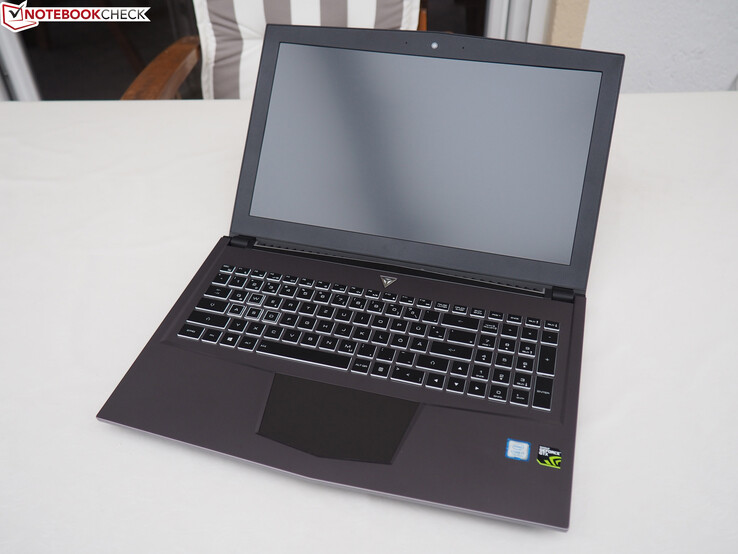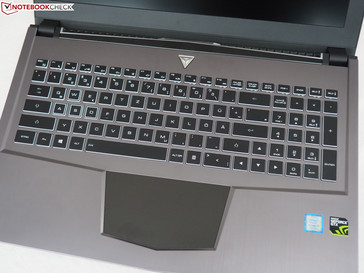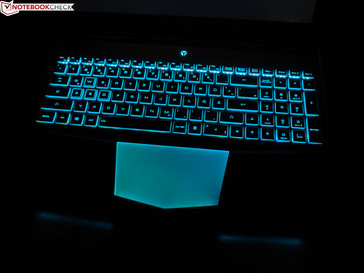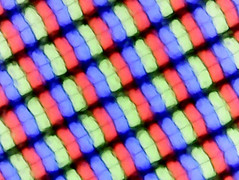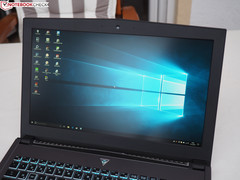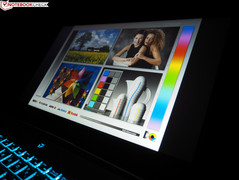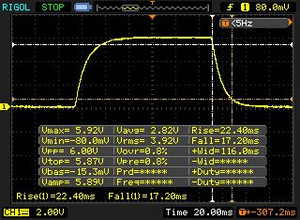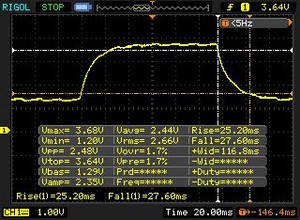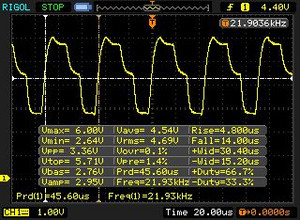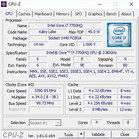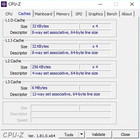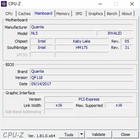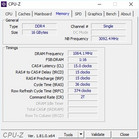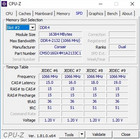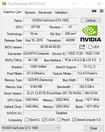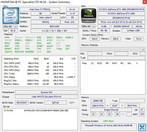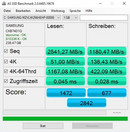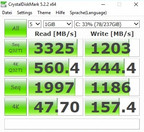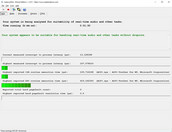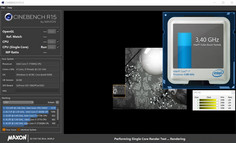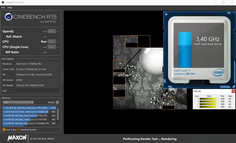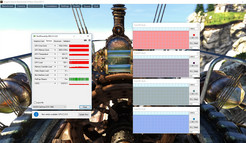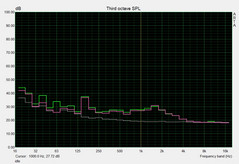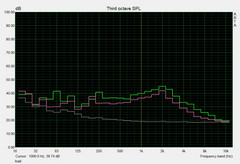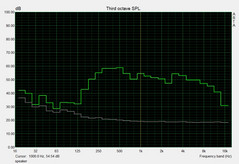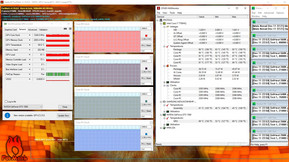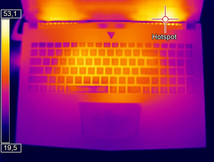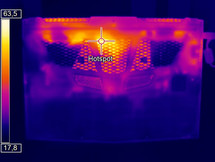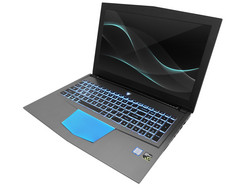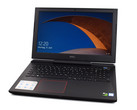PC Specialist Proteus V (i7-7700HQ, GTX 1060, Full HD) Laptop Review

For the original German review, see here.
OEMs such as Acer, Asus, or MSI usually offer preconfigured notebooks with little to no room for customization. PC Zentrum, on the other hand, allows you to configure your notebook freely to your liking. Admittedly, not all of the Proteus V’s components are swappable and configurable, but the configurator allows for quite a few upgrades and modifications, such as for example, the RAM that can be configured from anywhere between 4 GB to 32 GB (two slots).
Storage devices are also configurable, and given that the 15-inch notebook has two storage slots/bays (1x M.2, 1x 2.5-inch) there are plenty of options. The GPU menu includes a GeForce GTX 1060 with 6 GB of VRAM or a much more powerful GeForce GTX 1070 with 8 GB of VRAM. The processor and the display are not configurable, and therefore the notebook is always equipped with a Core i7-7700HQ and a matte FHD display. Unfortunately, the notebook does not support G-Sync or Optimus.
In return, the price is fairly low for a gaming notebook. Starting at 1.167 Euros (~$1382; at the time of writing in mid-December 2017) the final price obviously depends on your individual configuration. At the time of writing, our review unit equipped with a GeForce GTX 1060, a 256 GB NVMe SSD, and 16 GB of RAM would clock in at 1405 Euros (~$1663), which is reasonable compared to other GTX 1060 laptops, such as the Gigabyte P55W v7, the MSI GS63VR 7RF, the Schenker XMG Core 15, or the Acer V15 Nitro Black Edition.
Case
Despite various differences, the Proteus V’s case is based on a very similar bare bone shell as the XMG Core 15. A big difference is the case’s coating: while Schenker Technologies coats almost the entire case with a soft touch finish, PC Specialist has only gone for the bottom of the case. The top and display cover are made of silver-gray brushed aluminum instead. In addition to its good looks it also ensures a very high level of robustness and stability.
The various lighting options and possibilities are specifically geared towards gamers. For example, in addition to the keyboard the touchpad can also be illuminated. There are also light blue LED strips at the front and on the display lid. We have no complaints in terms of overall build quality. While gap consistency could be a teeny-tiny bit better here and there, the metal finish more than makes up for it. Whether you like the design or not, there is no denying the high-quality look and feel of the case.
Size-wise the Proteus V is fairly low-key and neither very large nor particularly small. With its thickness of 2.9 cm (~1.1 in), it sits somewhere between the 3.4 cm (~1.3 in) thick Gigabyte P55W v7 and the 1.8 to 2.3 cm (~0.7 to ~0.9 in) slim MSI GS63VR 7RF and Acer V15 Nitro. Even the Schenker XMG Core 15 is a bit slimmer (2.5 cm/~1 in). All competitors except for the 1.9 kg (~4.2 lb) light MSI GS63VR 7RF weigh somewhere between 2.5 and 2.6 kg (~5.5 and ~5.7 lb), and are therefore reasonably portable overall.
Connectivity
Ports
In terms of connectivity and port distribution the Proteus V is identical to the Schenker XMG Core 15. Two digital display outputs (HDMI & Mini DisplayPort), three USB 3.0 Type-A, and one USB 3.1 Gen.2 Type-C port should be more than enough for most gamers. Additional ports include an RJ45 Ethernet port, an SD card reader, a 3.5-mm audio jack, and a Kensington Lock. Unfortunately, the Proteus V lacks support for Thunderbolt 3, which means that it does not support external GPUs. The ports are mostly located on both sides towards the rear end of the device, but some might get in the way of an external mouse.
SD Card Reader
The included SD card reader supports SD, SDHC and SDXC and is mediocre at best. Transfer speeds of between 85 and 89 MB/s are similar to the Schenker Core 15 and the Gigabyte P55W v7. Still, it beats the likes of the MSI GS63VR 7RF or Acer V15 Nitro hands down: both are only equipped with USB 2.0 SD card readers and therefore limited to 21 to 27 MB/s.
| SD Card Reader | |
| average JPG Copy Test (av. of 3 runs) | |
| PC Zentrum Proteus V (Toshiba Exceria Pro SDXC 64 GB UHS-II) | |
| Schenker XMG Core 15 (Toshiba Exceria Pro SDXC 64 GB UHS-II) | |
| Gigabyte P55W v7 (Toshiba Exceria Pro SDXC 64 GB UHS-II) | |
| MSI GS63VR 7RF-228US (Toshiba Exceria Pro SDXC 64 GB UHS-II) | |
| Acer Aspire VN7-593G-73HP V15 Nitro BE | |
| maximum AS SSD Seq Read Test (1GB) | |
| PC Zentrum Proteus V (Toshiba Exceria Pro SDXC 64 GB UHS-II) | |
| Gigabyte P55W v7 (Toshiba Exceria Pro SDXC 64 GB UHS-II) | |
| Schenker XMG Core 15 (Toshiba Exceria Pro SDXC 64 GB UHS-II) | |
| Acer Aspire VN7-593G-73HP V15 Nitro BE | |
| MSI GS63VR 7RF-228US (Toshiba Exceria Pro SDXC 64 GB UHS-II) | |
Communication
In addition to Bluetooth 4.2, the Proteus V’s Wi-Fi modem made by Intel (according to AIDA64) also supports Wi-Fi 802.11 a/b/g/n/ac. Connected to our reference router (Linksys EA8500) the Wireless-AC 8260 averaged 520 Mbps transmitting and 686 Mbps receiving data, which is somewhere between good and very good.
Software
Unlike many other manufacturers, PC Specialist refrains from installing tons of unwanted bloatware on its devices, but focuses on a few important key aspects instead. Accordingly, the only two third party applications that we found preloaded on the notebook in addition to hardware drivers were trial versions of Microsoft Office and Internet Security BullGuard.
Accessories
The accessories included with the device deserve extra praise. Most notebooks these days lack a proper manual and recovery DVD for reinstalling the operating system from scratch. An extra DVD with various drivers and tools is also included. The included 200-W power supply (17 x 8 x 3.5 cm/~6.7 x 3.1 x 1.4 in) weighs a hefty 845 g (~1.9 lb).
Maintenance
In theory, maintenance should be a no-brainer. There are 7 visible Philips screws at the bottom and an extra hidden Philips screw underneath a plastic cover that need to be removed first. Unfortunately, even after undoing all these screws, we were unable to remove the bottom cover completely, and suspect that there may be more screws hidden underneath the rubber strip at the rear. Either that or the latches keeping the bottom cover in place are so tight that forcing them open might result in irreversible damage.
We suspect the insides to be very similar to the XMG Core 15 (see review thereof). By peeking through the fan vents we were able to make out a dual-fan system with several heat pipes. Both CPU and GPU are soldered onto the motherboard and not user-upgradeable but the RAM, the storage devices, and the Wi-Fi module should be.
Warranty
Instead of 24 months like most notebooks sold in Europe the Proteus V comes with a 36 month limited warranty (2 years on parts, 3 years on labor). In addition, pickup and return can be extended from one month to one or two years, and PC Specialist also offers a 0 stuck pixels warranty. Please see our Guarantees, Return Policies and Warranties FAQ for country-specific information.
Input Devices
Keyboard
All things considered the input devices were decent. Feedback could be a tad firmer but overall, the keyboard scored very well, thanks to its full-sized numpad and its beefy two-stage unicolor backlight.
The keyboard layout itself is very different from the XMG Core 15 and more similar to the likes of MSI, and therefore it is highly questionable. Major differences to the German default layout are the single-row return key and the relocated <>| key. Admittedly, this only affects the German keyboard layout, which is by default very different from the US or UK layouts. The discrepancies will be less bothersome for gamers and more for prolific typists. The arrow keys are also not exactly ideal – we do like the fact that they are just as large as any other key, but dislike the fact that the left and right arrow key extend into the main keyboard area and the numpad, respectively.
Touchpad
The touchpad has also been designed and optimized for gamers. Instead of placing it centered underneath the spacebar, the touchpad has been moved to the right in order to avoid accidental triggering while gaming.
Its shape is also peculiar, to say the least, as can be seen on the photos below: its width is between 11 cm (~4.3 in) at the bottom and 13 cm (~5.1 in) at the top. Vertical size is also not uniform, but given its overall height this turned out to be not that big of a deal. The touchpad is decently accurate and smooth, and supports gestures such as rotation, zoom, and two- or three-finger scrolling. Needless to say that in our tests, gesture detection was reliable and quick.
Display
The 60 Hz IPS display turned out to be only mediocre at best. On the plus side the panel’s contrast ratio of 1152:1 and black level of 0.21 nits are comparatively high and low, respectively.
| |||||||||||||||||||||||||
Brightness Distribution: 85 %
Center on Battery: 242 cd/m²
Contrast: 1152:1 (Black: 0.21 cd/m²)
ΔE ColorChecker Calman: 4.27 | ∀{0.5-29.43 Ø4.78}
ΔE Greyscale Calman: 2.17 | ∀{0.09-98 Ø5}
58% sRGB (Argyll 1.6.3 3D)
37% AdobeRGB 1998 (Argyll 1.6.3 3D)
40.42% AdobeRGB 1998 (Argyll 3D)
58% sRGB (Argyll 3D)
39.13% Display P3 (Argyll 3D)
Gamma: 2.38
CCT: 6912 K
| PC Zentrum Proteus V BOEhydis NV156FHM-N42 (BOE06C6), 1920x1080, 15.6" | Schenker XMG Core 15 LG Philips LP156WF6 (LGD046F), 1920x1080, 15.6" | MSI GS63VR 7RF-228US 3840x2160, 15.6" | Acer Aspire VN7-593G-73HP V15 Nitro BE LG Display LP156WF6-SPP1, 1920x1080, 15.6" | Gigabyte P55W v7 LG Philips LP156WF6 (LGD046F), 1920x1080, 15.6" | |
|---|---|---|---|---|---|
| Display | 52% | 24% | 56% | 50% | |
| Display P3 Coverage (%) | 39.13 | 64.3 64% | 48.21 23% | 65.8 68% | 63.5 62% |
| sRGB Coverage (%) | 58 | 83 43% | 72.6 25% | 85.1 47% | 82 41% |
| AdobeRGB 1998 Coverage (%) | 40.42 | 60.6 50% | 49.81 23% | 62.2 54% | 59.9 48% |
| Response Times | 23% | 44% | 18% | 34% | |
| Response Time Grey 50% / Grey 80% * (ms) | 52.8 ? | 40.8 ? 23% | 28 ? 47% | 41 ? 22% | 37 ? 30% |
| Response Time Black / White * (ms) | 39.6 ? | 30.4 ? 23% | 23.6 ? 40% | 34 ? 14% | 25 ? 37% |
| PWM Frequency (Hz) | 21930 ? | 20490 ? | 1351 ? | ||
| Screen | -11% | -59% | -2% | -6% | |
| Brightness middle (cd/m²) | 242 | 297 23% | 274.2 13% | 322 33% | 287 19% |
| Brightness (cd/m²) | 235 | 276 17% | 263 12% | 297 26% | 289 23% |
| Brightness Distribution (%) | 85 | 87 2% | 92 8% | 86 1% | 87 2% |
| Black Level * (cd/m²) | 0.21 | 0.3 -43% | 0.44 -110% | 0.31 -48% | 0.29 -38% |
| Contrast (:1) | 1152 | 990 -14% | 623 -46% | 1039 -10% | 990 -14% |
| Colorchecker dE 2000 * | 4.27 | 5.25 -23% | 8 -87% | 4.73 -11% | 4.92 -15% |
| Colorchecker dE 2000 max. * | 7.09 | 10.3 -45% | 14.6 -106% | 12.37 -74% | 11 -55% |
| Greyscale dE 2000 * | 2.17 | 4.64 -114% | 9.1 -319% | 2.99 -38% | 3.66 -69% |
| Gamma | 2.38 92% | 2.39 92% | 2.24 98% | 2.32 95% | 2.32 95% |
| CCT | 6912 94% | 6600 98% | 5020 129% | 6905 94% | 6482 100% |
| Color Space (Percent of AdobeRGB 1998) (%) | 37 | 54 46% | 45.7 24% | 56 51% | 54 46% |
| Color Space (Percent of sRGB) (%) | 58 | 83 43% | 72.1 24% | 85 47% | 82 41% |
| Total Average (Program / Settings) | 21% /
6% | 3% /
-29% | 24% /
12% | 26% /
11% |
* ... smaller is better
The downsides are its very low maximum brightness of no more than 235 nits and its poor color space coverage of 58% (sRGB) and 37% (AdobeRGB). Most gaming laptops offer significantly more. For example, the Schenker XMG Core 15’s panel covers 83% of the sRGB and 54% of the AdobeRGB color space. Subjectively, the display’s poor color space coverage results in a rather pale overall image that can best be noticed in a side-by-side comparison.
Gamers will be left particularly unimpressed by the panel’s slow response times. 40 ms black-to-white and 53 ms gray-to-gray are poor even by IPS standards. Despite the display’s matte finish outdoor usability was significantly limited by its low maximum brightness.
At least the panel’s viewing angles were decent and much better than on comparable TN panels. Brightness distribution was also almost perfect and backlight bleeding was limited to the bottom right corner.
Display Response Times
| ↔ Response Time Black to White | ||
|---|---|---|
| 39.6 ms ... rise ↗ and fall ↘ combined | ↗ 22.4 ms rise | |
| ↘ 17.2 ms fall | ||
| The screen shows slow response rates in our tests and will be unsatisfactory for gamers. In comparison, all tested devices range from 0.1 (minimum) to 240 (maximum) ms. » 97 % of all devices are better. This means that the measured response time is worse than the average of all tested devices (20.2 ms). | ||
| ↔ Response Time 50% Grey to 80% Grey | ||
| 52.8 ms ... rise ↗ and fall ↘ combined | ↗ 25.2 ms rise | |
| ↘ 27.6 ms fall | ||
| The screen shows slow response rates in our tests and will be unsatisfactory for gamers. In comparison, all tested devices range from 0.165 (minimum) to 636 (maximum) ms. » 89 % of all devices are better. This means that the measured response time is worse than the average of all tested devices (31.6 ms). | ||
Screen Flickering / PWM (Pulse-Width Modulation)
| Screen flickering / PWM detected | 21930 Hz | ≤ 95 % brightness setting | |
The display backlight flickers at 21930 Hz (worst case, e.g., utilizing PWM) Flickering detected at a brightness setting of 95 % and below. There should be no flickering or PWM above this brightness setting. The frequency of 21930 Hz is quite high, so most users sensitive to PWM should not notice any flickering. In comparison: 53 % of all tested devices do not use PWM to dim the display. If PWM was detected, an average of 8108 (minimum: 5 - maximum: 343500) Hz was measured. | |||
Performance
The Proteus V is a high-end gaming notebook despite the fact that the GeForce GTX 1060 is “only” Nvidia’s third-fastest notebook GPU (not taking Max-Q into account). In order to fully make use of this powerful GPU the rest of the components should be matched accordingly; we suggest at least 16 GB of DDR4-RAM and an SSD for the operating system.
Processor
The processor installed in the Proteus V is one of Intel’s most popular notebook CPUs from their current Kaby Lake line-up. The 14 nm Core i7-7700HQ has access to 6 MB of L3 cache and runs at 2.8 GHz or more, depending on the load. Maximum multi-core turbo boost was 3.4 GHz.
In single-core benchmarks, the Proteus V failed to reach its theoretical maximum of 3.8 GHz and consequently fell behind its competitors (see table).
| Cinebench R11.5 | |
| CPU Single 64Bit | |
| Schenker XMG Core 15 | |
| MSI GS63VR 7RF-228US | |
| PC Zentrum Proteus V | |
| CPU Multi 64Bit | |
| MSI GS63VR 7RF-228US | |
| PC Zentrum Proteus V | |
| Schenker XMG Core 15 | |
Sustained clock speeds are determined by running Cinebench R15’s multi-core test in a loop, and the Proteus V’s Core i7-7700HQ’s scores remained consistently high, even after the n-th iteration. Due to the fact that it does not support Optimus the CPU’s integrated GPU (Intel HD Graphics 630) remains unused. Accordingly, the system uses the Nvidia GPU at all times.
System Performance
System performance was a mixed bag. While the Proteus V outperformed the entire competition in PCMark 8’s Home Suite it fell behind the Schenker XMG 15 in PCMark 10 by up to 30 %, in part due to the latter’s much faster SSD. That said, these results have to be taken with a pinch of salt: PCMark tends to produce incomprehensible results every now and then.
| PCMark 8 - Home Score Accelerated v2 | |
| PC Zentrum Proteus V | |
| Schenker XMG Core 15 | |
| MSI GS63VR 7RF-228US | |
| Gigabyte P55W v7 | |
| PCMark 10 - Score | |
| Schenker XMG Core 15 | |
| PC Zentrum Proteus V | |
| PCMark 8 Home Score Accelerated v2 | 4916 points | |
| PCMark 10 Score | 3904 points | |
Help | ||
Storage Devices
When individually configuring the notebook, storage devices are the domain with the most options available. For maximum performance, an NVMe SSD is the way to go. We have opted for a 256 GB Samsung PM961 with sequential read and write speeds of up to 3325 MB/s and 1203 MB/s in CrystalDiskMark, respectively. Results are somewhat lower in AS SSD, but still fairly high, at 2,541 and 1180 MB/s read and write. SATA III SSDs like the one the Gigabyte P55W v7 is equipped with are limited to around 500 to 550 MB/s due to their interface. At the other end of the spectrum Samsung’s 960 EVO (Schenker XMG Core 15) and SM961 (MSI GS63VR 7RF) prove that there is still room for improvement.
If necessary, a cheap secondary 2.5-inch hard disk drive can be added for storing data as well. PC Zentrum offers sizes ranging from 500 GB to 2 TB.
| PC Zentrum Proteus V Samsung PM961 MZVLW256HEHP | Schenker XMG Core 15 Samsung SSD 960 Evo 250GB m.2 NVMe | MSI GS63VR 7RF-228US Samsung SM961 MZVKW512HMJP m.2 PCI-e | Acer Aspire VN7-593G-73HP V15 Nitro BE Seagate Mobile HDD 1TB ST1000LM035 | Gigabyte P55W v7 Liteonit CV3-8D256 | |
|---|---|---|---|---|---|
| AS SSD | 20% | 26% | -68% | ||
| Seq Read (MB/s) | 2541 | 2678 5% | 2719 7% | 514 -80% | |
| Seq Write (MB/s) | 1180 | 1172 -1% | 1550 31% | 328.1 -72% | |
| 4K Read (MB/s) | 51 | 46.56 -9% | 48.01 -6% | 23.34 -54% | |
| 4K Write (MB/s) | 136.4 | 142.9 5% | 127.6 -6% | 48.47 -64% | |
| Score Read (Points) | 1472 | 1639 11% | 1549 5% | 393 -73% | |
| Score Write (Points) | 677 | 1323 95% | 1468 117% | 248 -63% | |
| Score Total (Points) | 2842 | 3728 31% | 3756 32% | 840 -70% |
Graphics Card
Nvidia’s GeForce GTX 1060, a DirectX 12 GPU manufactured in a 16 nm process, features 1280 shaders and a total of 6 GB of GDDR5 VRAM accessed via a 192-bit wide bus.
| 3DMark - 1920x1080 Fire Strike Graphics | |
| PC Zentrum Proteus V | |
| Acer Aspire VN7-593G-73HP V15 Nitro BE | |
| Gigabyte P55W v7 | |
| Schenker XMG Core 15 | |
| MSI GS63VR 7RF-228US | |
| 3DMark 11 - 1280x720 Performance GPU | |
| PC Zentrum Proteus V | |
| Acer Aspire VN7-593G-73HP V15 Nitro BE | |
| Gigabyte P55W v7 | |
| Schenker XMG Core 15 | |
| MSI GS63VR 7RF-228US | |
Accordingly, the Proteus V’s graphics performance was very high. It even managed to outperform the entire GTX 1060-equipped competition in 3DMark 11 and 3DMark 13’s Fire Strike test by 3 to 6%. In everyday usage this difference is negligible though, and could possibly be caused by optimizations in the Proteus V’s newer drivers.
| 3DMark 11 Performance | 12205 points | |
| 3DMark Ice Storm Standard Score | 143270 points | |
| 3DMark Cloud Gate Standard Score | 26044 points | |
| 3DMark Fire Strike Score | 10010 points | |
Help | ||
Just like on the CPU we test sustained load on the GPU as well by running “The Witcher 3” in a loop for at least 60 minutes. During this test, both the clock speed (around 1600 MHz) and frame rates (36 to 42 FPS @ FHD/Ultra) remained consistent. Lengthy gaming sessions should thus not suffer from reduced performance. Unfortunately, this cannot be said about gaming on battery: like many of its high-performance brethren the Proteus V severely reduces clock speeds on battery as well. Frame rates in “The Witcher 3” fell by 65% and dropped to an unplayable 14 FPS.
Gaming Performance
On mains, graphics performance is more than decent. At the FHD panel’s native resolution most games will only manage to hit a wall on maximum settings with high levels of anti-aliasing enabled. More often than not, high details cause no problems at all, and in the rare cases where the Proteus V is incapable of running games smoothly at 60 FPS or more it is mostly due to poor game optimization (The Evil Within 2, Assassin‘s Creed Origins).
| The Witcher 3 | |
| 1920x1080 Ultra Graphics & Postprocessing (HBAO+) | |
| PC Zentrum Proteus V | |
| MSI GS63VR 7RF-228US | |
| Gigabyte P55W v7 | |
| Acer Aspire VN7-593G-73HP V15 Nitro BE | |
| Schenker XMG Core 15 | |
| 1920x1080 High Graphics & Postprocessing (Nvidia HairWorks Off) | |
| MSI GS63VR 7RF-228US | |
| PC Zentrum Proteus V | |
| Gigabyte P55W v7 | |
| Schenker XMG Core 15 | |
| Acer Aspire VN7-593G-73HP V15 Nitro BE | |
Generally speaking, the GeForce GTX 1060 is a decent graphics card for gaming in 1920 x 1080. The faster GeForce GTX 1070 makes sense for resolutions of 2560x1440 and above while the GTX 1080 is an absolute necessity for UHD/4K gaming at 3840x2160.
| low | med. | high | ultra | |
|---|---|---|---|---|
| The Witcher 3 (2015) | 72.2 | 39.9 | ||
| Middle-earth: Shadow of War (2017) | 68 | 52 | ||
| The Evil Within 2 (2017) | 43.4 | 41.8 | ||
| ELEX (2017) | 68.1 | 51.9 | ||
| Destiny 2 (2017) | 94.1 | 78.4 | ||
| Wolfenstein II: The New Colossus (2017) | 77.4 | 70.7 | ||
| Assassin´s Creed Origins (2017) | 57 | 47 | ||
| Call of Duty WWII (2017) | 93.8 | 70.4 | ||
| Need for Speed Payback (2017) | 77.8 | 73.7 | ||
| Star Wars Battlefront 2 (2017) | 80.6 | 62.3 |
Emissions
System Noise
System noise is by far the Proteus V’s biggest weakness. While the comparatively equipped Schenker XMG Core 15 remained fairly quiet in almost all situations, the Proteus V was very noticeable even when idling: 37 to 39 dB(A) are way too much and hint at rather poor fan speed control presets, particularly when taking into account that low-load scenarios such as working with office productivity suites, watching videos, or browsing the web will spin up the fans even further and result in a sound level of more than 40 dB(A). PC Specialist needs to address this issue right away.
An average of 47 dB(A) in 3DMark 06 and 52 dB(A) under maximum load is almost deafening. Oddly enough, the Proteus V remained comparatively quiet running “The Witcher 3” (43 dB(A)). That said, the MSI GS63VR 7RF and the Acer V15 Nitro are much slimmer than the Proteus V and consequently offer much less internal space for cooling.
Noise level
| Idle |
| 37 / 38 / 39 dB(A) |
| Load |
| 47 / 52 dB(A) |
 | ||
30 dB silent 40 dB(A) audible 50 dB(A) loud |
||
min: | ||
| PC Zentrum Proteus V GeForce GTX 1060 Mobile, i7-7700HQ | Schenker XMG Core 15 GeForce GTX 1060 Mobile, i7-7700HQ | MSI GS63VR 7RF-228US GeForce GTX 1060 Mobile, i7-7700HQ | Acer Aspire VN7-593G-73HP V15 Nitro BE GeForce GTX 1060 Mobile, i7-7700HQ | Gigabyte P55W v7 GeForce GTX 1060 Mobile, i7-7700HQ | |
|---|---|---|---|---|---|
| Noise | 12% | 10% | 11% | 9% | |
| off / environment * (dB) | 31 | 29 6% | 28.8 7% | 30.4 2% | 30 3% |
| Idle Minimum * (dB) | 37 | 31 16% | 33.1 11% | 30.9 16% | 33 11% |
| Idle Average * (dB) | 38 | 32 16% | 33.1 13% | 30.9 19% | 34 11% |
| Idle Maximum * (dB) | 39 | 34 13% | 34 13% | 31.5 19% | 35 10% |
| Load Average * (dB) | 47 | 41 13% | 37.2 21% | 40.7 13% | 39 17% |
| Witcher 3 ultra * (dB) | 43 | 39 9% | 46.1 -7% | 45.5 -6% | |
| Load Maximum * (dB) | 52 | 47 10% | 47.1 9% | 43.9 16% | 50 4% |
* ... smaller is better
Temperature
A positive side effect of fast spinning fans is the Proteus V’s moderate temperatures. Compared to the Schenker XMG Core 15, it remained between 5 to 10 °C (~9 to 18 °F) cooler both when idle and in 3D load scenarios. Overall, the Proteus V remained cooler than the Acer V15 Nitro but got warmer than the Gigabyte P55W v7.
Our review unit completed the stress test with no surprises. After 60 minutes of FurMark and Prime95 simultaneously, the Core i7-7700HQ’s temperature was measured at a high yet still acceptable 89 to 90 °C (~192 to 194 °F). Some gaming notebooks get very close to the CPU’s 100 °C (~212 °F) shutdown threshold despite throttling. The Proteus V on the other hand completed this test running at 3.4 GHz. The graphics card remained even cooler and only reached a maximum of 69 °C (~156 °F), partly because it was running at its base clock of 1240 MHz instead of its turbo boost clock of 1405 MHz. As far as we can tell, this only occurred during the not particularly realistic stress test scenario.
(±) The maximum temperature on the upper side is 44 °C / 111 F, compared to the average of 40.4 °C / 105 F, ranging from 21.2 to 68.8 °C for the class Gaming.
(-) The bottom heats up to a maximum of 53 °C / 127 F, compared to the average of 43.3 °C / 110 F
(+) In idle usage, the average temperature for the upper side is 26.9 °C / 80 F, compared to the device average of 33.9 °C / 93 F.
(±) Playing The Witcher 3, the average temperature for the upper side is 36.6 °C / 98 F, compared to the device average of 33.9 °C / 93 F.
(+) The palmrests and touchpad are reaching skin temperature as a maximum (33 °C / 91.4 F) and are therefore not hot.
(-) The average temperature of the palmrest area of similar devices was 28.9 °C / 84 F (-4.1 °C / -7.4 F).
| PC Zentrum Proteus V GeForce GTX 1060 Mobile, i7-7700HQ | Schenker XMG Core 15 GeForce GTX 1060 Mobile, i7-7700HQ | MSI GS63VR 7RF-228US GeForce GTX 1060 Mobile, i7-7700HQ | Acer Aspire VN7-593G-73HP V15 Nitro BE GeForce GTX 1060 Mobile, i7-7700HQ | Gigabyte P55W v7 GeForce GTX 1060 Mobile, i7-7700HQ | |
|---|---|---|---|---|---|
| Heat | -23% | 0% | -6% | 8% | |
| Maximum Upper Side * (°C) | 44 | 53 -20% | 51.9 -18% | 49.6 -13% | |
| Maximum Bottom * (°C) | 53 | 61 -15% | 54.6 -3% | 47.7 10% | |
| Idle Upper Side * (°C) | 29 | 35 -21% | 28.4 2% | 29.1 -0% | 23.6 19% |
| Idle Bottom * (°C) | 29 | 39 -34% | 29.6 -2% | 29.3 -1% | 24.6 15% |
* ... smaller is better
Speakers
Despite its built-in subwoofer, the sound quality was subpar, and in addition to lack of bass the Proteus V’s maximum volume was also very low. 65 dB(A) is too quiet, even for small rooms, and far too quiet for almost everything else. Our audio analysis further revealed that mids and highs are not very well balanced. Ignoring the low maximum volume, it still beat the Schenker XMG Core 15. Nevertheless, we suggest using headphones or external speakers instead, since using the integrated 2.1 speakers is anything but enjoyable.
PC Zentrum Proteus V audio analysis
(-) | not very loud speakers (65 dB)
Bass 100 - 315 Hz
(±) | reduced bass - on average 9.3% lower than median
(±) | linearity of bass is average (14.5% delta to prev. frequency)
Mids 400 - 2000 Hz
(+) | balanced mids - only 3.5% away from median
(±) | linearity of mids is average (7% delta to prev. frequency)
Highs 2 - 16 kHz
(+) | balanced highs - only 2.8% away from median
(±) | linearity of highs is average (8.9% delta to prev. frequency)
Overall 100 - 16.000 Hz
(±) | linearity of overall sound is average (22.6% difference to median)
Compared to same class
» 81% of all tested devices in this class were better, 5% similar, 14% worse
» The best had a delta of 6%, average was 18%, worst was 132%
Compared to all devices tested
» 66% of all tested devices were better, 6% similar, 29% worse
» The best had a delta of 4%, average was 24%, worst was 134%
Schenker XMG Core 15 audio analysis
(±) | speaker loudness is average but good (75 dB)
Bass 100 - 315 Hz
(±) | reduced bass - on average 8% lower than median
(±) | linearity of bass is average (11.7% delta to prev. frequency)
Mids 400 - 2000 Hz
(±) | higher mids - on average 10.1% higher than median
(±) | linearity of mids is average (13.2% delta to prev. frequency)
Highs 2 - 16 kHz
(+) | balanced highs - only 1.9% away from median
(±) | linearity of highs is average (7.5% delta to prev. frequency)
Overall 100 - 16.000 Hz
(±) | linearity of overall sound is average (23.6% difference to median)
Compared to same class
» 85% of all tested devices in this class were better, 4% similar, 11% worse
» The best had a delta of 6%, average was 18%, worst was 132%
Compared to all devices tested
» 70% of all tested devices were better, 6% similar, 24% worse
» The best had a delta of 4%, average was 24%, worst was 134%
Frequency diagram (checkboxes selectable/deselectable!)
Energy Management
Power Consumption
Regardless of the lack of Optimus, the Proteus V’s idle power consumption was far too high. A power draw of between 28 and 38 W is much higher than on the similarly equipped Schenker XMG Core 15 (18 to 26 W), whose GTX 1060 also lacks support for Optimus. Power consumption under load on the other hand was inconspicuous. 91 to 152 W is very close to the Acer V15 Nitro’s 82 to 155 W. The 200-W power supply is amply dimensioned.
| Off / Standby | |
| Idle | |
| Load |
|
Key:
min: | |
| PC Zentrum Proteus V GeForce GTX 1060 Mobile, i7-7700HQ | Schenker XMG Core 15 GeForce GTX 1060 Mobile, i7-7700HQ | MSI GS63VR 7RF-228US GeForce GTX 1060 Mobile, i7-7700HQ | Acer Aspire VN7-593G-73HP V15 Nitro BE GeForce GTX 1060 Mobile, i7-7700HQ | Gigabyte P55W v7 GeForce GTX 1060 Mobile, i7-7700HQ | |
|---|---|---|---|---|---|
| Power Consumption | 14% | 28% | 35% | 41% | |
| Idle Minimum * (Watt) | 28 | 18 36% | 14.5 48% | 7.2 74% | 8 71% |
| Idle Average * (Watt) | 32 | 22 31% | 17.3 46% | 10.5 67% | 13 59% |
| Idle Maximum * (Watt) | 38 | 26 32% | 17.4 54% | 16 58% | 18 53% |
| Load Average * (Watt) | 91 | 93 -2% | 93 -2% | 82 10% | 76 16% |
| Witcher 3 ultra * (Watt) | 124 | 119 4% | 128.8 -4% | 124 -0% | |
| Load Maximum * (Watt) | 152 | 175 -15% | 155 -2% | 143 6% |
* ... smaller is better
Battery Life
The notebook’s above-average power consumption has the expected negative impact on battery life. 89 minutes in Battery Eater’s Classic Test may still be acceptable for a gaming notebook, but 3:41 hours in the Readers Test at minimum brightness are anything but. In the real-world Wi-Fi test, the Proteus V lasted for only 3:16 hours and it ran out of juice playing HD videos after 3:20 hours. Both, the Acer V15 Nitro and the Gigabyte P55W v7, outlasted the Proteus V by what seem to be eons thanks to Optimus, and both lasted for around 6 hours (in other words: twice as long). Thus, the Proteus V is definitely the wrong choice for road warriors.
| PC Zentrum Proteus V GeForce GTX 1060 Mobile, i7-7700HQ, Wh | Schenker XMG Core 15 GeForce GTX 1060 Mobile, i7-7700HQ, 82 Wh | MSI GS63VR 7RF-228US GeForce GTX 1060 Mobile, i7-7700HQ, 65 Wh | Acer Aspire VN7-593G-73HP V15 Nitro BE GeForce GTX 1060 Mobile, i7-7700HQ, 69 Wh | Gigabyte P55W v7 GeForce GTX 1060 Mobile, i7-7700HQ, 63 Wh | |
|---|---|---|---|---|---|
| Battery runtime | 21% | 26% | 90% | 113% | |
| Reader / Idle (h) | 3.7 | 5 35% | 6.4 73% | 8.4 127% | 13.2 257% |
| H.264 (h) | 3.3 | 3.9 18% | |||
| WiFi v1.3 (h) | 3.3 | 4.7 42% | 3.9 18% | 6 82% | 5.8 76% |
| Load (h) | 1.5 | 1.3 -13% | 1.3 -13% | 2.4 60% | 1.6 7% |
Verdict
Pros
Cons
If battery life is not important and neither are internal speakers for listening to music, watching movies, or playing games, then the Proteus V by PC Specialist can be a viable alternative at a fair price. Besides the sleek case made in part of aluminum, we also liked the input devices.
Its overall performance is more than decent. Equipped with 16 GB of DDR4 RAM and an SSD the Proteus V can easily keep up with the likes of Acer, Asus, or MSI. Modern games run smoothly at the device’s native FHD resolution of 1920x1080 thanks to the Core i7-7700HQ processor and GTX 1060 graphics card.
Unfortunately, the FHD display turned out to be pretty poor. Despite its high contrast ratio and low black level, it simply does not get bright enough to leave a lasting positive impression, and it suffers from subpar color space coverage to boot. Fan speed controls need a massive revamp as soon as possible. The device’s low temperatures are a sign of way too aggressively spinning fans; fans have the potential to annoy the notebook’s users fairly quickly. Hopefully, PC Specialist is going to improve upon this with a future BIOS update.
Thus, at the time of writing, we would much rather recommend the somewhat warmer yet significantly quieter Schenker XMG Core 15 despite its lack of shiny metal surfaces. Other 15-inch competitors can be found in our (portable) top 10 list and the GTX 1060 benchmark page.
PC Zentrum Proteus V
- 12/16/2017 v6 (old)
Florian Glaser




